Asus TUF Gaming VG27AQ

Introduction
The Asus TUF Gaming VG27AQ sits in the entry level TUF line-up of gaming monitors, which according to Asus normally focuses on the essentials. Despite this, the VG27AQ is actually one of the first products to feature Asus’ new proprietary “ELMB-Sync” technology, allowing for the potentially game-changing combination of motion blur reduction with variable refresh rates. Being essentially algorithmically adaptive backlight strobing, ELMB-Sync can be thought of like a traditional strobing blur reduction backlight, but instead of constraining users to a fixed refresh rate it works across the panel’s full range. In-game motion blur during high-paced scenes can be significantly without resorting to capped frame rates and V-Sync.
Asus are first to market with the support for simultaneous blur reduction and variable refresh rate, something which is bound to attract the attention of gamers. The model we have with us at the moment is their 27″ VG27AQ, featuring an IPS technology panel with a 2560 x 1440 resolution. The screen has a native 144Hz refresh rate but can also support up to 165Hz via an overclocking feature. There is support for adaptive-sync for variable refresh rates meaning you can use the screen from compatible AMD FreeSync systems as well as NVIDIA G-sync. For NVIDIA, it has even been officially certified under the “G-sync Compatible” scheme. There is a 4ms G2G response time spec is offered, along with a 1ms MPRT spec which applies when using the ELMB blur reduction feature.
While technically part of the entry-level TUF line-up, the screen does offer an attractive, yet simple design which will be familiar to those who have used some of the existing ROG Swift range of screens. It may be in the TUF brand, but it still features a range of additional gaming extras from within the OSD menu too.
If you enjoy our work or would like to get early access to future reviews, please consider becoming a TFT Central supporter.
| Check Availability and Pricing – Affiliate Links |
|---|
| Amazon | Overclockers UK |
| TFTCentral is a participant in the Amazon Services LLC Associates Programme, an affiliate advertising programme designed to provide a means for sites to earn advertising fees by advertising and linking to Amazon.com, Amazon.co.uk, Amazon.de, Amazon.ca and other Amazon stores worldwide. We also participate in a similar scheme for Overclockers.co.uk. |
Specifications and Features
The following table gives detailed information about the specs of the screen as advertised:

The VG27AQ offers a good range of modern connectivity with 1x DisplayPort 1.2 and 2 x HDMI 2.0 offered for video connections. For PC connectivity the DisplayPort is the most common option, with HDMI being available then for connecting external games consoles or Blu-ray players potentially. Both will support variable refresh rates from AMD graphics cards or games consoles. From NVIDIA cards you can only use VRR over DisplayPort. The overclocked 155Hz refresh rate can only be used over DisplayPort.
The screen has an external power supply and comes packaged with the power cable and small brick that you need. A headphone output connection is provided for audio pass-through if you need it and there are also some basic 2x 2W RMS stereo integrated speakers. There are no USB ports on this model which is rare nowadays.
Below is a summary of the features and connections of the screen.

Design and Ergonomics
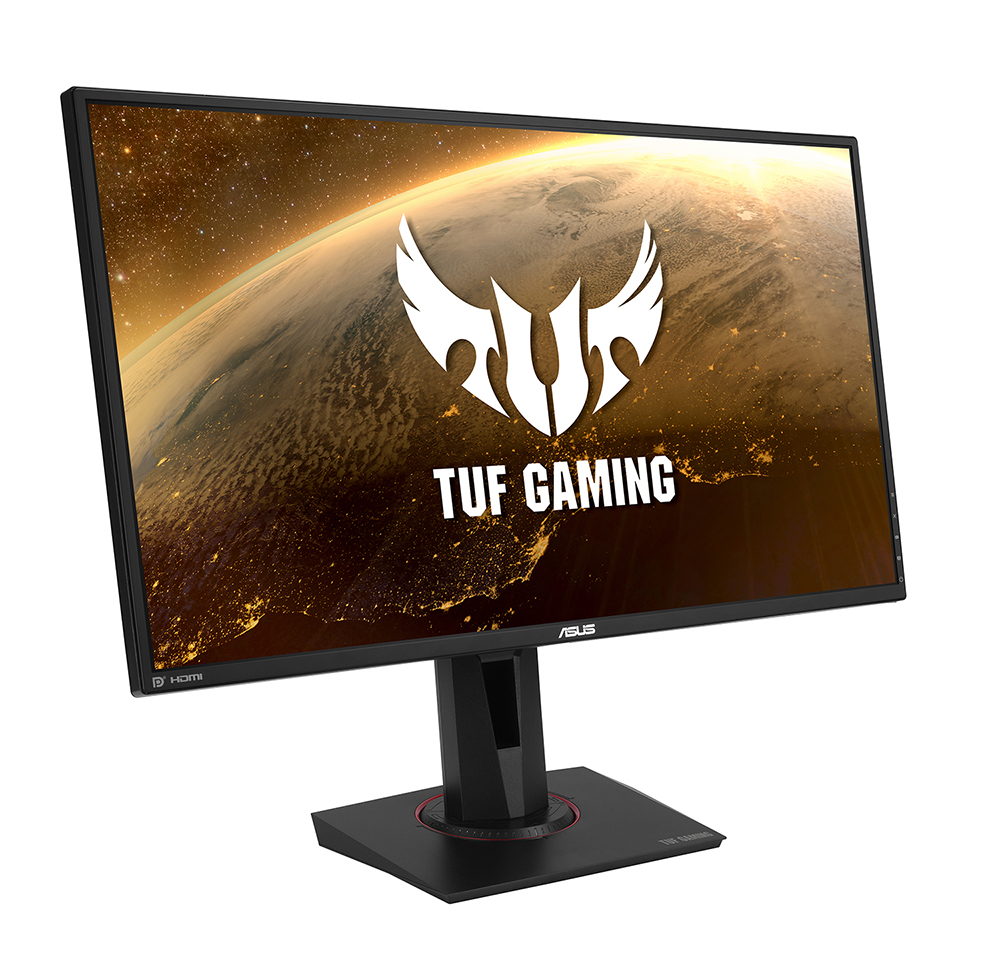
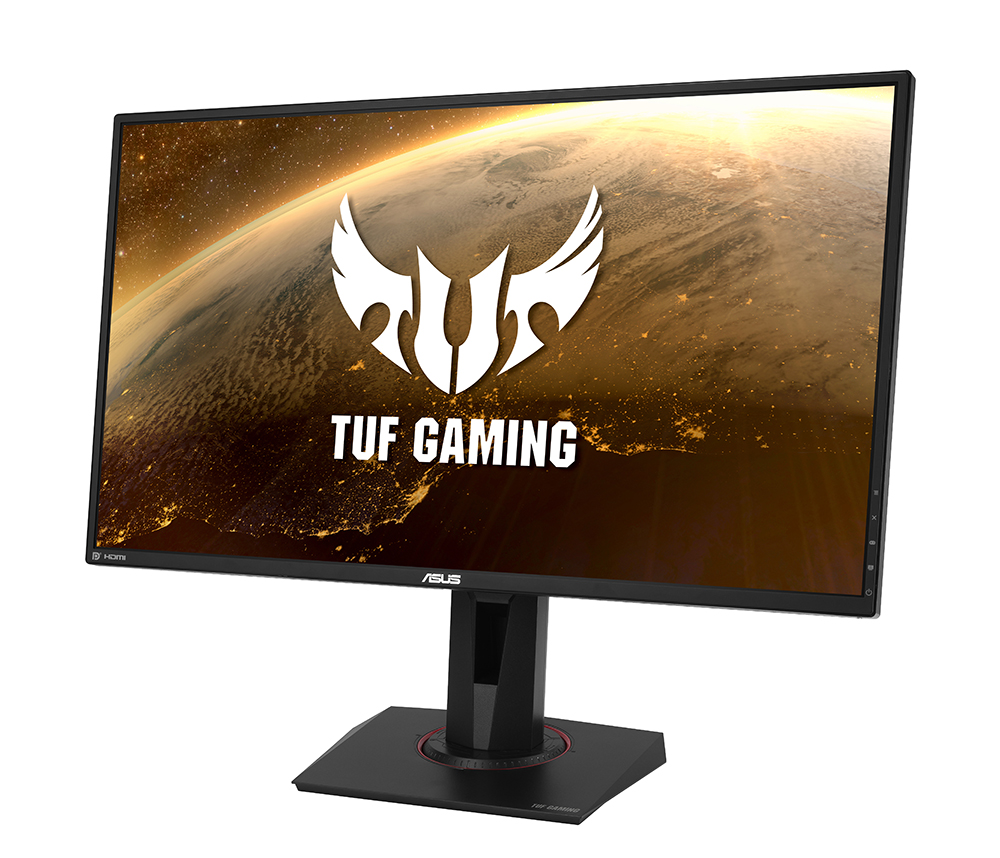
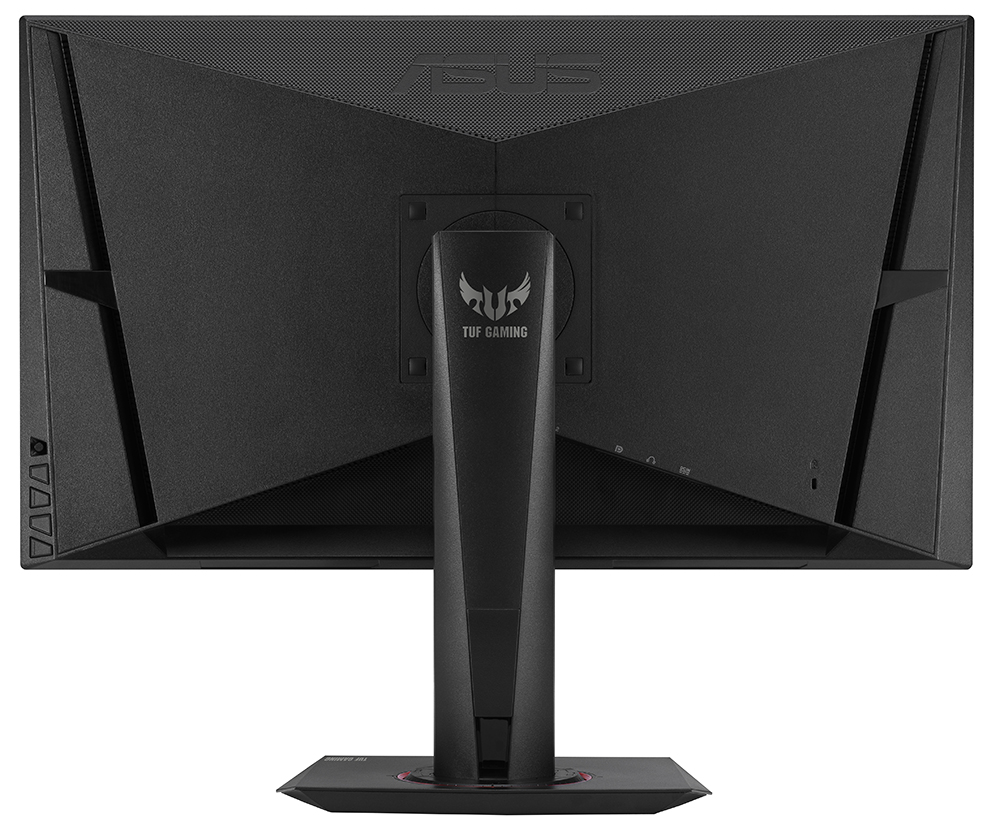
The VG27AQ comes in a black design with matte plastics used for the bezel, rear enclosure, arm and base. There is some small areas of red trim in places on the side of the stand and where the stand connects in to the base. The screen has thin bezels around all 4 sides, measuring 8mm along the sides and top, and 13mm along the bottom edge. There is also a thin black panel border of 2mm along the sides and top, and 1.5mm along the bottom. Overall though the borders look sleek and thin. There is a shiny silver Asus logo in the middle of the bottom bezel and on the right hand bottom edge there are pale grey labels for the OSD control buttons, which are tucked away behind the back of the right hand side.
The arm of the stand is finished in a matte black plastic as well, and connects in to the middle of the back of the screen. This does not have a quick release attachment, so has to be unscrewed if you want to remove it. This can be removed for VESA 100mm mounting if you wish though. The back of the screen is encased in matte black plastic and you can see the OSD control buttons and joystick shown here on the left hand side (as viewed from behind). There is a cable tidy hole in the bottom of the stand too.
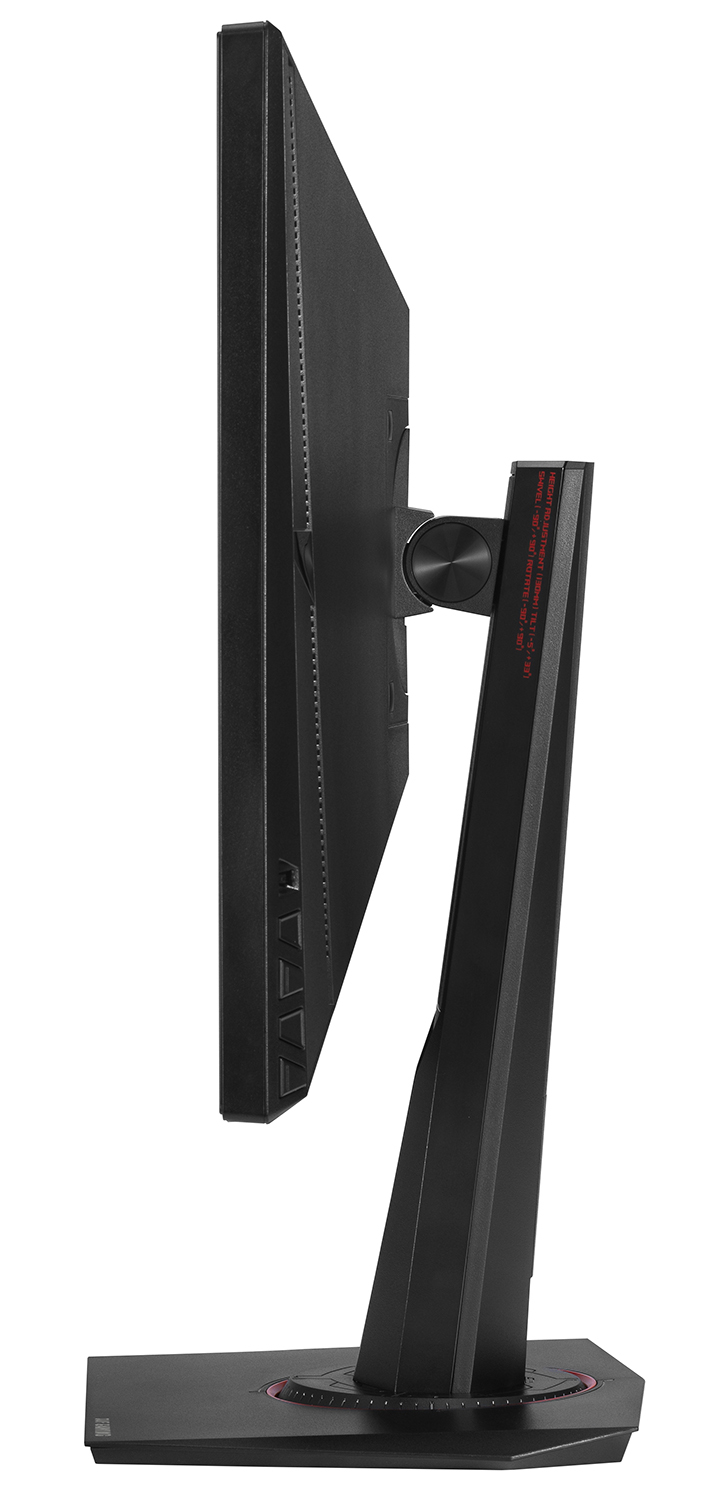
Above: side view of the screen. Click for larger version
The screen has a thin profile as you can see from above thanks to the W-LED backlighting and the external power supply (included in the box).
The stand offers a good range of ergonomic adjustments. Tilt provides a wide adjustment range and is smooth but a little stiff to operate. Height adjustment is smooth and easy to move. At the lowest height adjustment the bottom edge of the screen is very low to the desk, at about 15mm. At maximum extension it is 145mm which provides a 130mm total height adjustment range. The side to side swivel is easy and smooth to reposition and there is also a rotation function although it is a bit bumpy but easy enough to use. The screen remained stable with very little wobble when repositioning it which was pleasing. The build quality and adjustments felt solid.
A summary of the ergonomic adjustments are shown below:

The materials were of a good standard and the build quality felt decent. A fairly functional and modest design compared with some other gaming displays, with no RGB lights or fancy design elements like you might see on some recent ROG Swift or ROG Strix branded screens. There was no audible noise from the screen, even when conducting specific tests which can often identify buzzing issues. The whole screen remained cool even during prolonged use.


The back of the screen features the connections as shown above. Useful to see a headphone output provided although there are no USB ports which is rare nowadays.
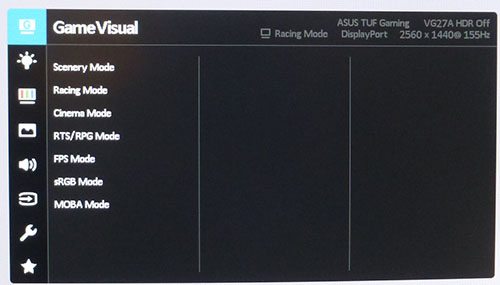
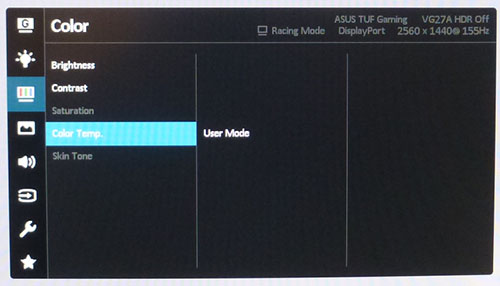
The OSD is controlled almost entirely through a single joystick on the back right hand edge of the screen. There are also 3 pressable buttons which give you quick access to certain settings including the GamePlus menu (crosshair, timer, FPS counter etc) and the GameVisual preset mode menu. Apart from that, you use the small joystick to navigate the main menu. This is split in to 8 sections down the left, with available options then shown in the next column and then available settings once you select one of those options shown in the next column to the right. There are quite a few settings to play with in the menu and navigation was quick and intuitive with the joystick.
Power Consumption

We have plotted these results below compared with other screens we have tested. The consumption (comparing the calibrated states) is comparable to the other 27″ high refresh rate IPS gaming screens we’ve tested. That is a little less than larger sized models in most cases.

Panel and Backlighting

Panel Part and Colour Depth
The VG27AQ features an AU Optronics M270Q008 V002 AHVA (IPS-type) technology panel. This is a different panel to other 1440p high refresh rate IPS screens we’ve seen to date, and actually not one of the typical panel parts. It looks like it might be a custom module for Asus, perhaps because of the new ELMB-sync technology. There is a 16.7m colour palette from an 8-bit colour depth offered. The panel part is confirmed when dismantling the screen as shown below:

Screen Coating
The screen coating is a light anti-glare (AG) offering. It isn’t a semi-glossy coating, but it is light as seen on other modern IPS type panels. Thankfully it isn’t a heavily grainy coating like some much older IPS panels feature and is also lighter than modern TN Film panel coating. It retains its anti-glare properties to avoid too many unwanted reflections of a full glossy coating, but does not produce too grainy or dirty an image that some thicker AG coatings can.
Backlight Type and Colour Gamut
The screen uses a W-LED backlight unit which is standard in today’s market. This helps reduce power consumption compared with older CCFL backlight units and brings about some environmental benefits as well. The W-LED unit here offers a standard colour gamut which according to the spec covers 99% of the sRGB gamut. There is no support for any wider colour spaces like DCI-P3 or Adobe RGB offered. If you want to read more about colour spaces and gamut then please have a read of our detailed article.
The backlight is dimmed using a direct current (DC) method as opposed to PWM, and so is flicker free as advertised.
Brightness and Contrast
This section tests the full range of luminance (the brightness of the screen) possible from the backlight, while changing the monitors brightness setting in the OSD menu. This allows us to measure the maximum and minimum adjustment ranges, as well as identify the recommended setting to reach a target of 120 cd/m2 for comfortable day to day use in normal lighting conditions. Some users have specific requirements for a very bright display, while others like a much darker display for night time viewing or in low ambient light conditions. At each brightness level we also measure the contrast ratio produced by the screen when comparing a small white sample vs. a black sample (not unrealistic full screen white vs. full screen black tests). The contrast ratio should remain stable across the adjustment range so we also check that.
Graphics card settings were left at default with no ICC profile or calibration active. Tests were made using an X-rite i1 Display Pro colorimeter. It should be noted that we used the BasICColor calibration software here to record these measurements, and so luminance at default settings may vary a little from the LaCie Blue Eye Pro report you will see in other sections of the review.

At the full brightness setting in the OSD the maximum luminance reached a fairly high 318 cd/m2 which was a bit less than the specified maximum brightness of 350 cd/m2 from the manufacturer. There was a moderate 204 cd/m2 adjustment range in total, so at the minimum setting you could reach down to a luminance of 114 cd/m2. This doesn’t afford you a very low luminance option for working in darkened room conditions with low ambient light however so be a little wary if that is a specific requirement for you. A setting of 3 in the OSD menu should return you a luminance of around 120 cd/m2 at default settings. It should be noted that the brightness regulation is controlled without the need for Pulse Width Modulation for all brightness settings so the screen is flicker free.


We have plotted the luminance trend on the graph above. The screen behaves as it should in this regard, with a reduction in the luminance output of the screen controlled by the reduction in the OSD brightness setting. This is a linear relationship.
The average contrast ratio of the screen was measured at a decent 1071:1 for an IPS-type panel.
Testing Methodology
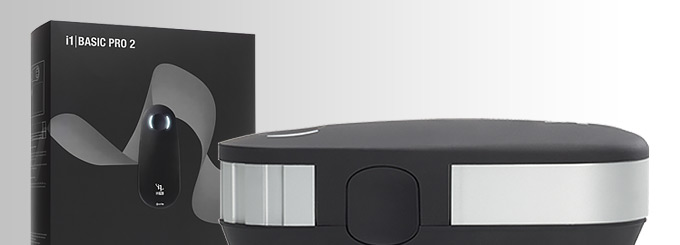
An important thing to consider for most users is how a screen will perform out of the box and with some basic manual adjustments. Since most users won’t have access to hardware colorimeter tools, it is important to understand how the screen is going to perform in terms of colour accuracy for the average user.
We restored our graphics card to default settings and disabled any previously active ICC profiles and gamma corrections. The screen was tested at default factory settings using our new X-rite i1 Pro 2 Spectrophotometer combined with LaCie’s Blue Eye Pro software suite. An X-rite i1 Display Pro colorimeter was also used to verify the black point and contrast ratio since the i1 Pro 2 spectrophotometer is less reliable at the darker end.
Targets for these tests are as follows:
- CIE Diagram – confirms the colour space covered by the monitors backlighting in a 2D view, with the black triangle representing the displays gamut, and other reference colour spaces shown for comparison. Usually shown as a comparison against the common sRGB space
- Colour space coverage volumes – we also measure using a piece of software called ChromaPure the colour space (gamut) volumes produced by the backlight in comparison to the sRGB, DCI-P3 and Rec.2020 colour spaces. sRGB is the most commonly used colour space so it is important to have a decent coverage from the screen here. If the colour space is >100% sRGB then the screen can produce a wider colour gamut, often reaching further in to the wider gamut DCI-P3 (commonly used for HDR) and Rec.2020 reference spaces.
- Gamma – we aim for 2.2 which is the default for computer monitors
- Colour temperature / white point – we aim for 6500k which is the temperature of daylight
- Luminance – we aim for 120 cd/m2, which is the recommended luminance for LCD monitors in normal lighting conditions
- Black depth – we aim for as low as possible to maximise shadow detail and to offer us the best contrast ratio
- Contrast ratio (static) – we aim for as high as possible. Any dynamic contrast ratio controls are turned off here if present
- dE average / maximum – we aim for as low as possible. If DeltaE >3, the color displayed is significantly different from the theoretical one, meaning that the difference will be perceptible to the viewer. If DeltaE <2, LaCie considers the calibration a success; there remains a slight difference, but it is barely undetectable. If DeltaE < 1, the color fidelity is excellent.
Default Performance and Setup
Default settings of the screen were as follows:

Initially out of the box the screen was set with the ‘Racing mode’ preset. The display was set with a random 63% brightness which was too bright and uncomfortable to use for long periods. You will want to turn that down. The colour balance felt good, not too warm or not too cool. We went ahead and measured the default state with the i1 Pro 2. The CIE diagram on the left of the image confirms that the monitors colour gamut (black triangle) extends only very slightly beyond the sRGB reference space (orange triangle), only really observable in blue shades. We measured using ChromaPure software a 106.7% sRGB gamut volume coverage which corresponds to 78.6% of the DCI-P3 reference and 56.4% of the Rec.2020 reference. This confirms the use of a standard gamut backlight, with only minor over-coverage which should present no problems in practice. There is no wider gamut option available on this particular display. Default gamma was recorded at 2.3 average with a fairly small 6% overall deviance from the target which was not bad. The gamma deviated further from our 2.2 target in the lighter grey shades. There are no gamma adjustment options available from within the OSD on this model, so we are at the mercy of the default setup here unless you can properly calibrate the screen using a colorimeter tool. White point was measured at 6381k, being only a small 2% too warm.
Luminance at the default 63% brightness level was recorded at a bright 276 cd/m2 which is too high for prolonged general use, you will need to turn that down. The black depth was 0.255 cd/m2 at this default brightness setting, giving us a solid (for an IPS-type panel) static contrast ratio of 1081:1. Colour accuracy measurements showed a fairly decent out of the box setup as well overall, with an average dE of 1.8. Although a maximum of 4.8 showed there was still some corrections to be made. There was no sign of any colour banding in gradient tests which was good news, just some slight gradation evident in darker tones.
Calibration
We used the X-rite i1 Pro 2 Spectrophotometer combined with the LaCie Blue Eye Pro software package to achieve these results and reports. An X-rite i1 Display Pro colorimeter was used to validate the black depth and contrast ratios due to lower end limitations of the i1 Pro device.

The OSD settings were adjusted as shown in the table above, as guided during the calibration process and measurements. These OSD changes allowed us to obtain an optimal hardware starting point and setup before software level changes would be made at the graphics card level. We left the LaCie software to calibrate to “max” brightness which would just retain the luminance of whatever brightness we’d set the screen to, and would not in any way try and alter the luminance at the graphics card level, which can reduce contrast ratio. These adjustments before profiling the screen would help preserve tonal values and limit banding issues. After this we let the software carry out the LUT adjustments and create an ICC profile.
Average gamma was corrected now to achieve the 2.2 average, correcting the fairly small 6% deviance we’d seen out of the box. The white point was measured at 6515k correcting the slightly too warm 2% deviance that we’d seen before out of the box. Luminance had been improved thanks to the adjustment to the brightness control and was now being measured at a far more comfortable 121 cd/m2. We did have to reduce the brightness control all the way down to 0% to get to our target luminance, so it doesn’t leave you anywhere else to go really if you want a darker screen. This is aimed at gaming, and so many people will want a brighter setup anyway. The blur reduction ‘ELMB-sync’ feature once enabled also reduces the brightness of the screen, so again if you’re gaming with that enabled it will have an impact. We measured a black depth of 0.12 cd/m2 and this produced a decent IPS static contrast ratio of 1024:1.
Colour accuracy of the resulting profile was excellent, with dE average of 0.3 and maximum of 1.5. LaCie would consider colour fidelity to be very good overall. Testing the screen with various colour gradients showed mostly smooth transitions with some minor gradation in darker tones, and some very minor banding in the darker shades due to the adjustment of the gamma curve. You can use our settings and try our calibrated ICC profile if you wish, which are available in our ICC profile database. Keep in mind that results will vary from one screen to another and from one computer / graphics card to another.
Setup Comparisons

The comparisons made in this section try to give you a better view of how each screen performs, particularly out of the box which is what is going to matter to most consumers. We have divided the table up by panel technology as well to make it easier to compare similar models. When comparing the default factory settings for each monitor it is important to take into account several measurement areas – gamma, white point and colour accuracy. There’s no point having a low dE colour accuracy figure if the gamma curve is way off for instance. A good factory calibration requires all 3 to be well set up. We have deliberately not included luminance in this comparison since this is normally far too high by default on every screen. However, that is very easily controlled through the brightness setting (on most screens) and should not impact the other areas being measured anyway. It is easy enough to obtain a suitable luminance for your working conditions and individual preferences, but a reliable factory setup in gamma, white point and colour accuracy is important and some (gamma especially) are not as easy to change accurately without a calibration tool.
From these comparisons we can also compare the calibrated colour accuracy, black depth and contrast ratio. After a calibration the gamma, white point and luminance should all be at their desired targets.

Default setup of the screen out of the box was good overall, despite this not carrying any specific factory calibration and being in the entry level line-up of gaming screens from Asus. Gamma was a little off and because there’s no gamma controls in the OSD menu this means it would be tricky to fully correct without a calibration tool. The decent sRGB coverage, contrast ratio and dE colour accuracy was pleasing.

The contrast ratio of the screen was fairly typical for a modern IPS-type panel at 1024:1 and was a decent enough result. If you need a higher contrast ratio for darker gaming and movies then a VA panel would be worth considering instead.
| Check Availability and Pricing – Affiliate Links |
|---|
| Amazon | Overclockers UK |
| TFTCentral is a participant in the Amazon Services LLC Associates Programme, an affiliate advertising programme designed to provide a means for sites to earn advertising fees by advertising and linking to Amazon.com, Amazon.co.uk, Amazon.de, Amazon.ca and other Amazon stores worldwide. We also participate in a similar scheme for Overclockers.co.uk. |
Viewing Angles

Above: Viewing angles shown from front and side, and from above and below. Click for larger version
Viewing angles of the screen were very good as you would expect from an IPS-type panel. Horizontally there was very little colour tone shift until wide angles past about 45°. A slight darkening of the image occurred horizontally from wider angles as you can see above as the contrast shifted slighting. Contrast shifts were slightly more noticeable in the vertical field but overall they were very good. The screen offered the wide viewing angles of IPS technology and was free from the restrictive fields of view of TN Film panels, especially in the vertical plane. It was also free of the off-centre contrast shift you see from VA panels and a lot of the quite obvious gamma and colour tone shift you see from some of the modern VA panel type offerings.

On a black image there is a characteristic pale glow introduced to the image when viewed from a wide angle, commonly referred to as IPS glow. This type of glow is common on most modern IPS-type panels and can be distracting to some users. If you view dark content from a normal head-on viewing position, you may see this glow as your eyes look towards the edges of the screen. The level of glow on this panel was comparable to other high refresh rate AUO IPS panels we’ve tested in the past such as the Asus ROG Swift PG279Q.
This type of glow is common on most modern IPS-type panels and can be distracting to some users. If you view dark content from a normal head-on viewing position, you may see this glow as your eyes look towards the edges of the screen depending on your viewing position. It will also be more noticeable in darker ambient light conditions and if you’re viewing a lot of dark content. Some people may find this problematic if they are playing a lot of darker games or watching darker movies. In normal day to day uses you couldn’t really notice this unless you were viewing darker content. If you move your viewing position back, which is probably likely for movies and games keep in mind, the effect reduces as you do not have such an extreme angle from your eye position to the screen edges.
Panel Uniformity
We wanted to test here how uniform the brightness was across the screen, as well as identify any leakage from the backlight in dark lighting conditions. Measurements of the luminance were taken at 35 points across the panel on a pure white background. The measurements for luminance were taken using BasICColor’s calibration software package, combined with an X-rite i1 Display Pro colorimeter with a central point on the screen calibrated to 120 cd/m2. The below uniformity diagram shows the difference, as a percentage, between the measurement recorded at each point on the screen, as compared with the central reference point.
It is worth noting that panel uniformity can vary from one screen to another, and can depend on manufacturing lines, screen transport and other local factors. This is only a guide of the uniformity of the sample screen we have for review.
Uniformity of Luminance

Luminance uniformity of the screen was good overall, with the top right hand corner showing the only significant deviance on our sample. In that corner the luminance dropped down to 102 cd/m2 in the most extreme example (-18%). Overall, 80% of the screen remained within a 10% deviance threshold of our centrally calibrated point which was good.
Backlight Leakage
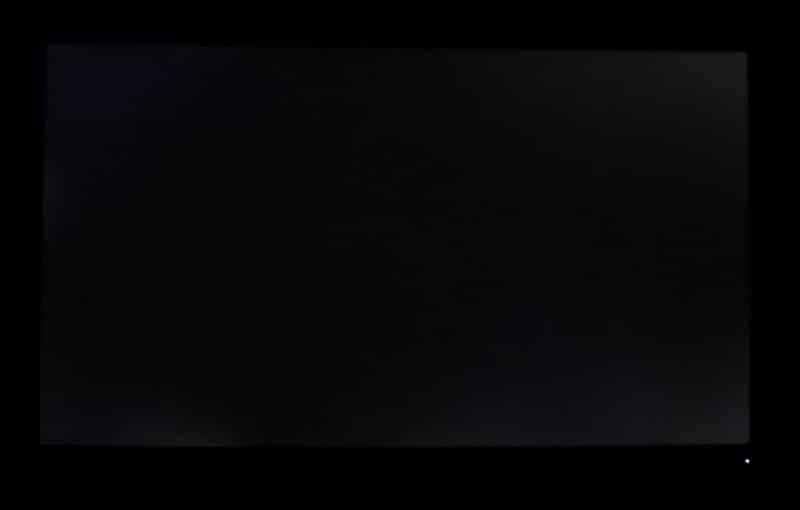
We also tested the screen with an all black image and in a darkened room. A camera was used to capture the result. There was a bit of clouding from the corners visible, and a little bit of leakage along the left hand edge. Nothing too severe though thankfully, or anything you could see during normal day to day uses.
Note: if you want to test your own screen for backlight bleed and uniformity problems at any point you need to ensure you have suitable testing conditions. Set the monitor to a sensible day to day brightness level, preferably as close to 120 cd/m2 as you can get it (our tests are once the screen is calibrated to this luminance). Don’t just take a photo at the default brightness which is almost always far too high and not a realistic usage condition. You need to take the photo from about 1.5 – 2m back to avoid capturing viewing angle characteristics, especially on IPS-type panels where off-angle glow can come in to play easily. Photos should be taken in a darkened room at a shutter speed which captures what you see reliably and doesn’t over-expose the image. A shutter speed of 1/8 second will probably be suitable for this.
General and Office Applications
This screen features a 2560 x 1440 WQHD resolution, a significant step up from the wide range of 1920 x 1080 screens on the market and a comfortable resolution for this size screen we feel. These higher resolution 27″ models offer a tighter pixel pitch of 0.233mm which results in a smaller text size than common 24″ 1080p screens, although it is still a nice and comfortable size. We are very used to working with 27″ 1440p screens all the time and find them very comfortable and a significant upgrade over 1080 / 1200p models. Some users may find the small text a little too small to read comfortably, and we’d advise caution if you are coming from a smaller screen for instance where the pixel pitch and text are normally larger. The extra screen size takes some getting used to over a few days as there really is a lot of room to work with but once you do, it’s excellent. For those wanting a high resolution for CAD, design, photo work etc, this is a really good option. The image was very sharp and crisp and text was very clear. With its WQHD display, you enjoy 77% more desktop space than a full HD screen to spread out your windows and palettes.
The light AG coating of the IPS technology panel is certainly welcome, and much better than the older grainy and ‘dirty’ appearance of older IPS AG coatings. Although it’s been several years since those more grainy coatings were used. The wide viewing angles provided by this panel technology on both horizontal and vertical planes, helps minimize on-screen colour shift when viewed from different angles.
There is a decent enough out of the box setup on this screen with fairly accurate gamma curve, good white point, decent IPS contrast ratio, good sRGB coverage and a good colour accuracy. The brightness range of the screen was limited though for these kind of uses, with the ability to offer a luminance between 318 and 114 cd/m2 in the default mode. Actually once we’d switched to the ‘user mode’ colour temperature for the calibration process, the minimum luminance reached was around 121 cd/m2 in the central area which was even more restrictive. This might mean that you are more limited in darker room conditions and low ambient light. Although getting down to 120 cd/m2 will still be adequate for many users. Again, this is a gaming screen and so most people will want the brighter settings for gaming, especially if you want to use the strobing blur reduction backlight as well. We would have just liked to see a lower minimum adjustment for office and general uses ideally.
A setting of ~3 in the OSD brightness control should return you a luminance close to 120 cd/m2 out of the box. The brightness regulation is controlled via a flicker free backlight, without the need for Pulse Width Modulation (PWM), and so those who suffer from eye fatigue or headaches associated with flickering backlights need not worry.


Spectral distribution graph showing calibrated Racing mode at 6500k (top) and Blue Light Filter Level 1 mode (bottom)
There was no audible noise from the screen, even when conducting specific tests which can sometimes cause issues. There is no specific office or reading preset mode available, but the screen does have 4 levels of Blue Light Filter available in the menu (and a 0 mode = off). Above we have included the spectral distribution graphs for our calibrated state at 6500k and the Level 1 blue light filter mode for reference. The Blue light filter modes are basically just presets where the white point has been adjusted. Level 1 is about 5500k and this gets a little warmer as you increase the blue light filter mode. In each one you can still alter things like the brightness control, except in the Level 4 mode where it is locked as some undisclosed value. The level 4 mode looks very yellow as well, and is about 4800k. One annoying thing about these modes is that if you enable any of them, it reverts your RGB controls back to 100,100,100. When you then turn the blue light filter off to level 0, the RGB levels still stay at 100 each, even if you’d previously changed them during calibration like we did. You can get around this easily enough by saving your calibrated settings in one of the 3 favourite modes though which you then just activate again if you turn the blue light filter off.
Unusually there are no USB ports on this screen, something quite rare from any monitor nowadays and missed a bit for these kind of general uses. There are also no other extras like ambient light sensors or card readers on this screen either. There is a decent enough range of ergonomic adjustments from the stand which are all pretty easy to adjust and move. There is also VESA 100mm mounting capabilities for those who want to arm or wall mount the screen instead.
Responsiveness and Gaming

The screen uses overdrive technology to boost pixel transitions across grey to grey changes as with nearly all modern displays. The part being used is an AU Optronics M270Q008 v002 AHVA (IPS-type) technology panel. Have a read about response time in our specs section if you need additional information about this measurement.
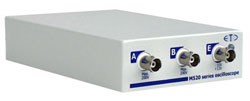 |  |
We use an ETC M526 oscilloscope for these measurements along with a custom photosensor device. Have a read of our response time measurement article for a full explanation of the testing methodology and reported data.
Response Times and Refresh Rate
There’s various things you need to consider when it comes to response times and gaming, particularly on a display with high refresh rate support. Gaming screens invariably give you a control for the overdrive impulse in the OSD menu which can help you tweak things, but response time performance and overshoot levels can vary depending on the active refresh rate. This behaviour is often different depending on whether the screen is a traditional G-sync screens (with hardware module) or whether it’s an adaptive-sync screen as well, and not all screens behave in the same way. We always try to test each variable in our reviews but the key considerations you need to make are:
- Performance at 60Hz – this is important if you want to use an external games console (or other device like a Blu-ray player etc) which typically run at 60Hz. Response time performance may well be different than at the higher refresh rates supported, and you may need a different overdrive setting for optimal experience.
- Performance during VRR (Variable Refresh Rate) – bearing in mind that the refresh rate will fluctuate anywhere from 1Hz up to the maximum supported by the screen (e.g. 1 – 144Hz on a 144Hz display). It’s important to understand if the response times and overshoot will vary as the refresh rate changes. There may be a need to switch between different overdrive settings in some cases, depending on your usually attained refresh rate output and graphics card capability. This can sometimes become fiddly if your refresh rates fluctuate a lot, especially between different games, so it’s always easier if you can leave a display on a single overdrive setting which is suited to the whole range. Some screens also feature “variable overdrive” which helps control the response times and overshoot depending on the active refresh rate. This is particularly apparent with traditional G-sync module screens.
- Performance at fixed refresh rates including maximum – this is important for those who have a powerful enough system to consistently output a frame rate to meet the max refresh rate capability of the screen. They may want to run at max refresh rate without VRR active, or even is VRR is active they may know they will be consistently at the upper end of the range. Many gaming screens show their optimal response time performance at the maximum refresh rate. Knowing the performance at high fixed refresh rates may also be applicable if you want to use any added blur reduction backlight which typically operate at a fixed refresh rate.
- Whether the response times can keep up with the frame rate – you will also want to consider whether the response times of the panel can consistently keep up with the frame rate. For instance a 144Hz screen sends a new frame to the display every 6.94ms, so the pixel response times need to ideally be consistently and reliably under this threshold. If they are too slow, it can lead to added blurring in practice and sometimes make the higher refresh rates unusable in real life. We consider this in our analysis.

We carried out some initial response time measurements and visual tests in each of the overdrive settings, and at a range of refresh rates. The overdrive control is available in the OSD menu via the ‘Trace Free’ (referred to as TF here) option as shown. There are 6 levels available from 0, 20, 40, 60, 80, 100 giving you a fairly wide configuration range to play with.

60Hz Optimal Settings
We are going to start with 60Hz here as it’s simpler to explain the overall performance by doing so. 60Hz may be applicable if you intend to use an external device like a games console or Blu-ray player with the screen, and you also need to consider this when it comes to variable refresh rates although we will talk about that a bit more in a moment.


We first of all tested the screen with overdrive turned off, using the TF = 0 setting. You can see that response times are pretty slow, with an average 11ms G2G measured. That’s still fast enough to keep up with the slower 60fps frame rate, but the rise times are quite slow (changes from dark > light shades). As a result, with TF = 0 there is some smearing of darker shades on moving content which isn’t ideal. It’s not as bad as the black smearing you see from most VA technology panels we should point out though.
If you switch up to the next level which is TF = 20 the response times improve significantly. We now measured an average 6.2ms G2G. However, there was some high levels of overshoot introduced, especially on the rise times. This results in some pale halos behind moving objects, particularly evident on lighter coloured backgrounds. Unfortunately the screen isn’t well suited to 60Hz content to be honest, as you either have to live with slower response times in the TF = 0 mode, or overshoot which is pretty noticeable and distracting at the next level up on TF = 20. We’d probably recommend TF = 20 on balance, but you’d have to put up with some moderate levels of overshoot.
This screen is more aimed at high refresh rate PC gaming and not ideally suited to console inputs or lower refresh rates.
100Hz Measurements
We then took some measurements at 100Hz. You can see the same slow response times with TF = 0 mode (overdrive turned off) at 12ms G2G. At the next step up of TF = 20 the response times were improved a lot to 7.1ms, and thankfully unlike at 60Hz the overshoot was not nearly as bad. There was a bit there, but it was much harder to see in practice and not very obtrusive. Pushing up to TF = 40 made very little difference to either the response times or overshoot but was the optimal balance we felt at this refresh rate. Above TF = 40 the overshoot started to become a bit too noticeable, even more so by the time you reached TF = 80 where it was too severe. You get lots of pale halos and artefacts on moving content at those higher TF settings. We haven’t bothered to measure TF = 100 here as overshoot was already too bad at 80.





144Hz Measurements
We then took some measurements at the maximum native 144Hz refresh rate. TF = 60 had previously been too aggressive at 100Hz, but here at 144Hz there was no noticeable overshoot in practice at all which was good. TF = 80 was useable too in fact, with minimal overshoot creeping in to our measurements and visual tests, and not really very visible in practice at all. TF = 100 was tested too, but the overshoot started to become a problem again with pale halos. Either TF = 60 or 80 seems optimal at this refresh rate, depending on whether you find there’s too much visual overshoot at 80. Using 60 made life a bit easier for when using VRR if your refresh rate drops down to around 100Hz though (more on that later).



Overclocking

We also tested the overclocking feature of the screen. This surprised us a little actually, as the original press release and even the Asus spec page say that this screen offers a 155Hz overclocking capability. You have to enable it from the OSD menu as shown above at which point the screen reboots quickly, and you can then select the new refresh rates in your graphics card settings. Once enabled we found that actually the screen will support overclocked refresh rates of 155Hz, 160Hz and 165Hz! So this was beyond the advertised figure. Results may vary from one system to another and from one sample to another so perhaps this is to give some flexibility for you to try additional settings above the advertised 155Hz. Asus confirmed for us that all documentation and websites are in the process of being updated to reflect the true 165Hz capability. If you experience issues with flickering or anything using any of the overclocked modes, you will probably want to try one step down, or just revert back to the native 144Hz.



You can see the response times at 155Hz and 165Hz above, using TF = 80 which we had found to be useable at 144Hz before and slightly faster than the TF = 60 mode. The response times reduce ever so slightly as you increase within the overclocking modes, not by anything noticeable but from 5.4ms G2G down to 5.7ms G2G when you reach 165Hz maximum. In doing so, the overshoot does reduce a bit too, so it’s arguably a better overall balance.
However, to keep up with the frame rate demands you need response times to keep up. At 155Hz a new frame is sent to the screen ever 6.45ms, and the response times are generally fast enough to keep up with this. Visually the 155Hz mode looked pretty much indistinguishable from the 144Hz mode. At 165Hz you need a new frame every 6.06ms, and we felt that overall the response times weren’t quite fast enough. A little (not much) added blurring was seen on moving content tests. We felt that 144Hz and 155Hz are pretty comparable overall both from the measurements we have taken, and from visual tests.
Variable Refresh Rates (VRR)
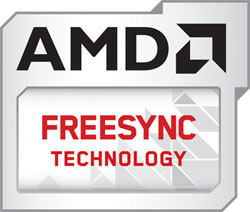
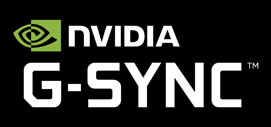
The screen natively supports AMD FreeSync for variable refresh rates between 40 and 144Hz, or 40 – 165Hz over DisplayPort if you enable the overclocking option. As listed on AMD’s website the screen is not certified under their newer FreeSync 2 scheme, despite it also including LFC support and accepting an HDR input signal (more on the HDR capabilities later). AMD FreeSync Technology is supported with DisplayPort and HDMI connections, allowing the screen to be compatible with AMD Radeon Graphics Cards (and modern NVIDIA cards for G-sync), Xbox X, Xbox One, and other future gaming consoles and devices that support FreeSync and Adaptive-Sync.
The VG27AQ has also been officially certified under NVIDIA’s recent ‘G-sync Compatible’ scheme, so you can use it from NVIDIA graphics cards with variable refresh rates with validated performance levels. It will support VRR over DisplayPort only.
The support for FreeSync and G-sync will be very useful given the significant system demands of running a screen at 2560 x 1440 resolution and up to 155Hz refresh rate. It was of course very good to see it included here. We will discuss some of the considerations for using VRR in the following section when it comes to response time performance. You might also want to read our newly updated article about Variable Refresh Rates here.
Detailed Response Times
Unfortunately the response time performance of the VG27AQ was a little complicated, and it will need some considerations to be made when gaming depending on your refresh rate and setup. This makes it a little more difficult to use than some screens where response time performance is more consistent, or where a variable overdrive impulse is used to control the balance between response times and overshoot. Unfortunately this is a pretty common picture for FreeSync screens, we’ve seen it many times before.
The VG27AQ is not ideal for 60Hz inputs to be honest, but if you do want to use a games console we would probably stick with the TF = 20 setting. Try TF = 0 perhaps if the overshoot becomes too noticeable. If you are going to use the screen at a fixed maximum 144Hz or overclocked 155 – 165Hz refresh rate then TF = 60 or 80 delivers the optimal performance which is actually very good (see detailed measurements below). We preferred the slightly more aggressive 80 mode where overshoot was lower, but try both. This is fine if you are not using VRR or can consistently deliver in the upper end of the refresh range range when you do use VRR.
If you are going to use VRR you need to consider what your common refresh rate performance is going to be from your graphics card and system. If you can consistently deliver in the upper range around 130 – 165Hz we would go with TF = 60 or 80 for optimal performance. Maybe drop this to 60 if you’re more commonly going a bit lower down to the 110 – 130Hz range. If you’re down nearer 80 – 110Hz we would probably drop TF down to 40 even. Anything below 80Hz you’re probably going to want to go with TF = 20 but it’s not great performance at that lower refresh rate end. You may instead want to consider a different screen, or if you want this model in particular for it’s features/price then maybe consider investing in a newer graphics card, or turn down your in games settings to achieve a higher refresh rate.
Recommended Settings
| Optimal Refresh Rate | 155Hz |
| Optimal Overdrive Setting (for above) | 60 or 80 |
| Optimal Overdrive Setting for 60Hz | 20 or 0 |
| Optimal Overdrive Setting for VRR | Depends on achieved refresh rate 130 – 165Hz = 60 or 80 110 – 130Hz = 60 80 – 110Hz = 40 <80Hz = 20 |
155Hz, Trace Free = 80


We carried out some further response time measurements at 155Hz overclocked refresh rate. We selected this refresh rate because it offered a slightly better balance of response times and overshoot than at 144Hz, and remained fast enough to keep up with the frame rate. The extra 11Hz might also be of some minor benefit in terms of perceived motion clarity or supporting slightly higher frame rates as well. We stuck with the TF = 80 setting which we felt at this refresh rate and the upper end above ~130Hz delivered the optimal performance. You could pick out some pale halos in practice, but nothing too major. If this starts to become too noticeable in practice, drop down to the TF = 60 mode where response times drop a bit, and you get a few slower black > grey transitions that leads to a little added black smearing. However overshoot is reduced quite a lot.
We measured an overall average response time now of 5.1ms G2G. Rise times were slightly faster than fall times but this was at the cost of some moderate to high levels of overshoot. As a result you could see some pale halos, especially on lighter colours. The maximum overshoot was 28.8% on the rise times and we could classify the overall overshoot performance as moderate (amber in our colour coding). 86.7% of the measured transitions were within the refresh rate window, or 100% if you allowed an additional 1ms leeway. This shows the screen is just fast enough to keep up with the 155Hz overclocked refresh rate. Visually this 155Hz mode looked very similar to 144Hz, and without the slight added blurring you get by pushing up to 165Hz where the response times aren’t quite fast enough to keep up.
Gaming Comparisons

We have provided a comparison of the display against many other gaming screens we have reviewed in a similar size range and across a range of panel technologies. This table is now split by panel technology to make life a bit easier and for quicker comparison.
The VG27AQ is one of the fastest IPS panels we’ve tested if you consider purely the G2G response times (5.1ms average). It’s very comparable to the Asus ROG Swift PG279Q (5.0ms) which is a good thing. However, there is some moderate overshoot on the VG27AQ while using the TF = 80 mode that was needed to achieve these measurements. You can drop down to TF = 60 and eliminate a lot of the overshoot, although response times are then not quite as fast. As we’ve already discussed, the VG27AQ is a little bit more fiddly than some of the screens here when considering VRR and different refresh rate options, but in keeping with most of the FreeSync displays we’ve tested which behave in a similar way. We would have liked a little less overshoot on the VG27AQ, and a better performance at lower <80hz refresh rates, but overall the response times were decent and could support the high refresh rate on offer.

ELMB-Sync
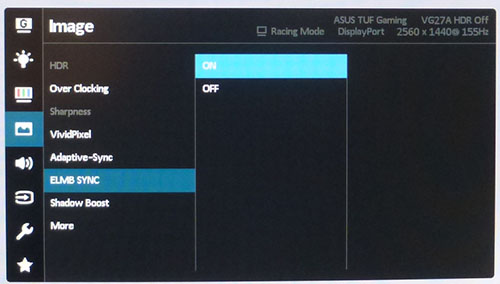
The strobing blur reduction backlight option is available via the ELMB-Sync setting. This is Asus’ added “Extreme Low Motion Blur” mode, which on this particular screen can also be used at the same time as FreeSync/G-sync, hence the “sync” in the name. That is a feature which separates this display (and a couple of other recent options from Asus) from all other blur reduction displays on the market. Those are limited to a fixed refresh rate if you want to use the strobing backlight, but here it can be used at the same time as VRR.
Once enabled the screen’s brightness setting reverts to a default of 90, but it is available to change in the OSD menu if you want. In fact most of the OSD settings remain accessible, with the notable exception of the Trace Free (response time) control. That is greyed out, and it’s not possible to tell at which setting it’s been locked.

Example strobing at 144Hz, horizontal scale = 5ms (Adaptive-sync OFF)
The behaviour of the strobing varied depending on whether you had adaptive-sync enabled and a FreeSync/G-sync graphics card connected. With Adaptive-sync turned off, we measured the strobing at a range of refresh rates including 165, 155, 144, 120 and 100Hz and confirmed that in each case the strobing was in sync with the refresh rate. So at 144Hz for example (shown above) there was a new strobe every 6.94ms. You get one distinct strobe per refresh rate cycle as shown above.
With adaptive-sync off (or connected to a non FreeSync/G-sync graphics card) It was not possible to enable the ELMB-Sync feature at a fixed 60Hz refresh rate it should be noted, 100Hz was the minimum setting you could use for a fixed refresh rate with this mode turned on. This is common for nearly all strobing blur reduction backlights in the market, as at lower refresh rates the flickering becomes more visible and distracting.

Example strobing at 144Hz, horizontal scale = 5ms (Adaptive-sync ON)
However, if you enabled adaptive-sync and connected the screen to a suitable FreeSync/G-sync system then the strobing behaved slightly differently. There was a small double-strobing going on here. At refresh rates from 100 – 165Hz each double strobe was in time again with the refresh rate cycle. Visually there was little difference between the two modes and we can only assume that this different strobing method was more suitable to coping with the refresh rate changes during FreeSync/G-sync operation and VRR.
With adaptive-sync turned on, you could actually use the ELMB feature at 60Hz as well, although we wouldn’t advise it really. We had this working on an AMD FreeSync system (Radeon RTX590) without issue, but oddly it didn’t seem to work from an NVIDIA G-sync system (GeForce GTX1080). Results may vary. Note: there is a different vertical scale used on the graph below, but the strobes are actually the same height.

Example strobing at 60Hz, horizontal scale = 5ms (Adaptive-sync ON)
You get the same double strobing at 60Hz with adaptive-sync on, but it is not in sync with the refresh rate properly. There are actually 2.5 of the “big strobes” per refresh rate cycle, so every 16.66ms. In practice the image looks pretty blurry at 60Hz, even with ELMB turned on. You could also seem some noticeable overshoot and pale trails behind moving objects at 60Hz, which weren’t visible at the higher refresh rates.
If you are investing in a gaming screen like this with a high refresh rate and added ELMB-sync feature, you are going to want to ensure your system and graphics card can deliver in that upper 100 – 165Hz range really anyway to get the most out of the screen in terms of frame rate, motion clarity and also response times.
Brightness ELMB-Sync Mode (Adaptive=sync OFF)
| Brightness Setting | Luminance | Black Point | Contrast Ratio |
| 100 | 160.17 | 0.15 | 1068:1 |
| 50 | 127.33 | 0.12 | 1061:1 |
| 0 | 91.43 | 0.09 | 1016:1 |
Brightness ELMB-Sync Mode (Adaptive=sync ON)
| Brightness Setting | Luminance | Black Point | Contrast Ratio |
| 100 | 199.12 | 0.18 | 1070:1 |
| 50 | 162.05 | 0.15 | 1056:1 |
| 0 | 120.23 | 0.12 | 1030:1 |
We measured the luminance output of the screen with ELMB-Sync enabled, and at different brightness settings. This was done at 165Hz for the table above, although the active refresh rate only has a minor impact on brightness output anyway. We completed the tests for both a fixed ELMB refresh rate (without VRR active) and for when using the feature with VRR where the brightness capability was a little higher. The screen does allow a reasonable upper brightness level which is good news, as many blur reduction modes offer restrictive brightness levels. It’s nice also to see user control over the brightness, without it being locked like on some other screens. Also good to see that it has no impact on the contrast ratio.
Maximum Blur Reduction Brightness – Display Comparison
For ease of reference we have also provided a comparison table below of all the blur reduction enabled displays we’ve tested, showing their maximum luminance before blur reduction is turned on (normal mode) and their maximum luminance with the feature enabled. This will give you an idea of the maximum brightness you can expect from each model when using their blur reduction feature, if that is important to you. A lot of people want a brighter display for gaming and sometimes the relatively low maximum luminance from blur reduction modes is a limitation.
These comparisons are with the refresh rate as high as is available for the blur reduction feature to function. For most this is at 100 – 144Hz. You can achieve a slightly brighter display if you use the feature at compatible lower refresh rates since the strobes are less frequent, but it’s not a significant amount. That can also introduce more visible flicker in some situations.

Note: Pulse Width setting at max where applicable.
*Note 2: The Acer XB270HU was later updated to include a 120Hz mode, which will produce a slightly darker maximum luminance
Blur Reduction Tests
Of course the main thing we want to test is what improvements the Blur Reduction mode offers when it comes to motion clarity and gaming. The following pursuit camera photos give you an indication of observed motion clarity as the human eye would see it at the top, middle and bottom areas of the screen. These were captured at the optimal 155Hz refresh rate although results were very comparable for lower refresh rates measured of 144 and 100Hz for instance. The only expectation was for much lower refresh rates like 60Hz where you could also see some noticeable overshoot appear in the form of pale halos.
As with most strobing blur reduction backlights it did help improve eye tracking of moving objects across the screen, making them sharper and easier to follow. That’s one of the key benefits of this kind of technology. However, you can see from the below photos that all areas of the screen showed some noticeable strobe cross-talk, where a trailing ghost image follows behind the moving UFO. This is caused by the timing of the strobe. It’s not possible to eliminate this across the whole screen, but usually there is a region where it is optimised, often in the central area where most of your attention would be focused during use. On this screen the middle region did deliver the clearest image, but it was still not ideal. The upper and lower regions showed much high levels of cross talk as you can see.
You’ll have to experiment in games to see how you find it, but we would have liked to see a bit less strobe cross talk ideally. In practice and games it’s harder to see than in these specific tests, and it’s quite similar to other recent and very popular IPS displays like the Gigabyte Aorus AD27QD and LG 34GK950F for instance in their blur reduction modes overall. We have just seen better when it comes to strobe cross-talk in the past from other displays (for instance the Acer Nitro XF252Q). As with our response time measurements, we would advise using the screen for higher refresh rates of 100Hz+ to avoid additional problems with motion clarity as at the lower refresh rate end, the overshoot starts to become a bit too obvious. ELMB-sync is certainly usable and helps improve motion clarity overall, making tracking of moving objects easier. The fact you can use this at the same time as FreeSync/G-sync is a nice additional bonus for those where their refresh rate will vary. It’s just wise to make sure that it doesn’t vary too much in to the lower end.
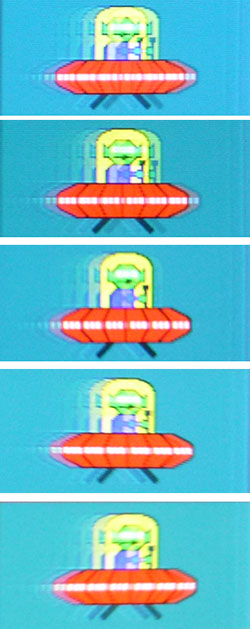
Pursuit camera photos capturing motion clarity from the top, to the middle and bottom areas of the screen (155Hz)
Additional Gaming Features
- Aspect Ratio Control – the screen has only 2 settings for hardware level aspect ratio control. There are options for ‘full’ or 4:3 modes which is a little odd. The screen is 16:9 natively so most external devices are going to be fine without needing scaling anyway which is good, but it would have been nice to see a mode to maintain the source aspect ratio whatever it might be, or maybe a 1:1 pixel mapping mode as well. The screen is aimed largely at PC gaming, and you can take care of aspect ratio control via the graphics card menu anyway so it’s not a major deal.
- Preset Modes – There are a few different preset modes aimed at gaming that can be customised and used if you want. This includes modes for FPS and RTS for instance, and 3 user modes you can save how you want.
- GamePlus menu– there are settings in the OSD for a familiar cross hair graphic to be added to the screen. There is also an on screen timer, FPS counter, display alignment adjuster and “sniper” crosshair mode. These are all accessible via the quick launch buttons on the back of the screen too for easy access. Within the main OSD there is also a Shadow Boost feature if you want to alter the gamma for improving visibility in darker content.
Lag
Read our detailed article about input lag and the various measurement techniques which are used to evaluate this aspect of a display. The screens tested are split into two measurements which are based on our overall display lag tests and half the average G2G response time, as measured by our oscilloscope. The response time element, part of the lag you can see, is split from the overall display lag and shown on the graph as the green bar. From there, the signal processing (red bar) can be provided as a good estimation of the lag you would feel from the display. We also classify each display as follows:
Lag Classification
- Class 1) Less than 8.33ms – the equivalent to 1 frame lag of a display at 120Hz refresh rate – should be fine for gamers, even at high levels
- Class 2) A lag of 8.33 – 16.66ms – the equivalent of one to two frames at a 120Hz refresh rate – moderate lag but should be fine for many gamers. Caution advised for serious gaming
- Class 3) A lag of more than 16.66ms – the equivalent of more than 2 frames at a refresh rate of 120Hz – Some noticeable lag in daily usage, not suitable for high end gaming


The total lag measured was a very impressive 2.80 ms. With around 2.55ms of that accounted for by the pixel response times we can calculate a signal processing lag of only 0.25ms, so basically nothing at all. A very impressive result from this display and making it suitable for fast and competitive gaming.
Movies and Video
The following summarises the screens performance for videos and movie viewing:
| Category | Display Specs / Measurements | Comments |
| Size | 27″ widescreen | Fairly typical for a desktop monitor nowadays and smaller than TV’s by a lot |
| Aspect Ratio | 16:9 | Well suited to most common 16:9 aspect content and input devices |
| Resolution | 2560 x 1440 | Can support native 1080p content, but not Ultra HD natively |
| HDCP | Yes | Suitable for encrypted content |
| Connectivity | 1x DisplayPort 1.2 and 2x HDMI 2.0 | Useful additional 2x HDMI input for external Blu-ray players or games consoles. |
| Cables | DisplayPort and HDMI | Both DisplayPort and HDMI provided which is useful |
| Ergonomics | Tilt, height, swivel and rotate | Fairly good range of adjustments suitable to positioning the screen in a variety of angles for different viewing positions. Easy to use and reposition |
| Coating | Light Anti-glare | Provides clear, non-grainy image and avoids unwanted reflections of full glossy solutions |
| Brightness range | 114 – 318 cd/m2 | Fairly limited at the upper brightness end relative to many modern displays, and limited at the lower adjustment range if you are watching in darker room conditions. Flicker free backlight operation with no PWM |
| Contrast | 1024:1 after calibration | Good IPS contrast ratio which should still be fine for most content and offering good shadow detail. Buying an alternative VA technology panel would provide you a higher contrast ratio if you watch a lot of dark content and miss some shadow detail |
| Preset modes | Cinema | There is a specific movie or video preset mode for Cinema which is brighter and cooler than our calibrated state, but which can be customised to suit your liking |
| Response times | 5.1ms G2G with moderate levels of overshoot at 144 / 155Hz (TF = 80) 11ms G2G at 60Hz with no overshoot (TF = 0) | Response times are good overall at higher refresh rates although with some moderate overshoot. The problem comes for 60Hz inputs and external devices where you either have to live with high overshoot (TF = 20) or slower response times (TF = 0). Not ideally suited to 60Hz external inputs on this display sadly. |
| Viewing angles | Very good | Thanks to the IPS panel technology, suitable for viewing from a wide range of positions. IPS glow on dark content could present a problem from some wider angles especially in darker room conditions |
| Backlight bleed | No major bleed | Some slight clouding in the corners on our sample but nothing major |
| Audio | Headphone output 2x 2W speakers | Basic integrated speakers on this model for the occasional YouTube video or movie trailer, but not up to much else. There is also a headphone jack is provided |
| Aspect Ratio Controls | Full and 4:3 modes only | Very limited options to account for non-16:9 format inputs apart from 4:3, although the native aspect of the screen is likely to be suitable for a lot of content and external devices anyway |
| PiP / PbP | Neither supported | n/a |
HDR (High Dynamic Range)

The screen can take an HDR10 input signal but has no local dimming capability, so cannot truly offer an improved dynamic range. It has a peak brightness of less than 400 cd/m2 so doesn’t even carry the rather meaningless HDR400 certification. It also doesn’t offer an extended colour gamut or 10-bit colour depth, so overall there is no real display capability to support HDR.
Conclusion
If you enjoy our work and want to say thanks, or would like to get early access to future reviews please consider becoming a TFT Central supporter.
The VG27AQ is certainly an interesting new screen, and it’s always great to see new technologies emerge. Motion blur reduction backlights have been around for several years now and many people really value these for their gaming, helping to reduce perceived motion blur and make the whole experience sharper and clearer. The fact that these have until now been limited to a fixed refresh rate has caused some people problems, particularly in modern games and on older systems where refresh rates vary in practice and you ideally need support for VRR. Having to choose between the benefits of using G-sync/FreeSync to support your VRR, and the benefits of using a blur reduction backlight has sometimes been tricky. Now with the arrival of the new ELMB-sync screens that need to choose has been eliminated.
The VG27AQ is primarily a gaming screen and it performs well overall we felt for fast PC gaming. As with most Adaptive-sync/FreeSync capable screens, getting to the optimal overdrive mode is a little fiddly and you have to take in to account your refresh rate performance. However, for upper refresh rates of 100 – 165Hz the performance is really good, with fast response times, very low input lag and high frame rate support. Overshoot is at moderate levels at what we consider the optimal overdrive mode, although in practice it’s not overly distracting as long as you can maintain the higher refresh rates. This upper refresh rate window is also where the ELMB-sync blur reduction mode performs optimally and this works well across VRR as well as at fixed refresh rates. We would have liked to see a bit less strobe cross talk ideally, but again in practice it’s not overly obvious. The overclocking mode seemed to work well, and we preferred the 155Hz mode overall, with the max 165Hz being a little too much for the pixel response times to manage. Being able to support NVIDIA G-sync (with G-sync Compatible certification even) and AMD FreeSync is obviously a big bonus, giving you flexibility over your graphics card choice now and in the future. The screen is geared towards high refresh rate PC gaming for sure, and it did struggle a bit with the lower refresh rates, both for external 60Hz inputs (like a console) and when ELMB-sync reached down in the lower 80Hz and below range.
Away from gaming the default setup of the screen was good overall, contrast ratio was solid, and the screen offered the good all-round performance you get from an IPS-type panel. We would have liked to see a more flexible backlight adjustment to allow for lower brightness levels in darker room conditions, but this has really been sacrificed in favour of instead supporting higher brightness for gaming uses and for when ELMB-sync is active. The design, functionality and build quality were all good as well, despite this model being part of what is supposed to be the more entry-level TUF Gaming brand. Nice to see Asus have not cut many corners with this display to fit in to that range. If you’re a fan of motion blur reduction backlights and want to be able to use it with a G-sync/FreeSync at the same time, this is a solid first offering from one of the main gaming monitor brands. The screen is available from most regions, you can check latest pricing and availability below using the links provided.
| Pros | Cons |
| Strong overall gaming experience with adaptive-sync, high refresh rate support and good response times | Limited low level brightness adjustment for darker room conditions |
| ELMB-sync works well including at variable refresh rates, although best at 100Hz+ range | ELMB-sync shows moderate strobe crosstalk, a bit more than we would ideally like |
| Very low input lag | Limited experience for lower refresh rates <80Hz and for external console inputs |

| Check Availability and Pricing – Affiliate Links |
|---|
| Amazon | Overclockers UK |
| TFTCentral is a participant in the Amazon Services LLC Associates Programme, an affiliate advertising programme designed to provide a means for sites to earn advertising fees by advertising and linking to Amazon.com, Amazon.co.uk, Amazon.de, Amazon.ca and other Amazon stores worldwide. We also participate in a similar scheme for Overclockers.co.uk. |
We may earn a commission if you purchase from our affiliate links in this article- TFTCentral is a participant in the Amazon Services LLC Associates Programme, an affiliate advertising programme designed to provide a means for sites to earn advertising fees by advertising and linking to Amazon.com, Amazon.co.uk, Amazon.de, Amazon.ca and other Amazon stores worldwide. We also participate in a similar scheme for Overclockers.co.uk, Newegg, Bestbuy , B&H and some manufacturers.
Stay Up to Date
 |  |  |  |
| Browser Alerts | Follow on X | Subscribe on YouTube | Support Us |
Popular Trending Reviews
 Asus ROG Strix XG27AQWMG October 22, 2025 Featuring a new 27″ 1440p 280Hz 4th Gen Primary RGB Tandem WOLED panel and a True Black glossy screen coating. Is this an OLED game-changer?
Asus ROG Strix XG27AQWMG October 22, 2025 Featuring a new 27″ 1440p 280Hz 4th Gen Primary RGB Tandem WOLED panel and a True Black glossy screen coating. Is this an OLED game-changer? Dell Alienware AW3225QF February 29, 2024 The new 32″ 4K QD-OLED monitor from Dell, with a 240Hz refresh rate, Dolby Vision HDR and even eARC sound support
Dell Alienware AW3225QF February 29, 2024 The new 32″ 4K QD-OLED monitor from Dell, with a 240Hz refresh rate, Dolby Vision HDR and even eARC sound support Gigabyte AORUS FO32U2P April 23, 2024 The new 32″ 4K 240Hz QD-OLED monitor from Gigabyte, featuring the first proper, full-speed DisplayPort 2.1 connectivity support
Gigabyte AORUS FO32U2P April 23, 2024 The new 32″ 4K 240Hz QD-OLED monitor from Gigabyte, featuring the first proper, full-speed DisplayPort 2.1 connectivity support AOC Gaming Q27G3XMN September 24, 2024 Mini LED at a very attractive price point! The AOC Q27G3XMN offers 27″ 1440p VA panel, 180Hz refresh, HDR 1000 and 336-zone Mini LED backlight
AOC Gaming Q27G3XMN September 24, 2024 Mini LED at a very attractive price point! The AOC Q27G3XMN offers 27″ 1440p VA panel, 180Hz refresh, HDR 1000 and 336-zone Mini LED backlight Asus ROG Swift PG32UCDM February 14, 2024 One of the first 32″ 4K 240Hz OLED monitors released to market featuring a 3rd gen QD-OLED panel, USB type-C, KVM, and many Asus extras
Asus ROG Swift PG32UCDM February 14, 2024 One of the first 32″ 4K 240Hz OLED monitors released to market featuring a 3rd gen QD-OLED panel, USB type-C, KVM, and many Asus extras
